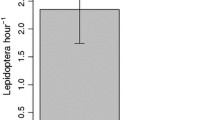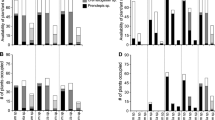Abstract
The coexistence of phylogenetically related species is an attractive topic because of the potentially intense interspecific competition. The most often investigated mechanisms mediating coexistence of these species are environmental filtering and niche partitioning. However, the role of other factors, such as species-specific parasites, is still poorly understood. Along the riparian understory of a tropical forest, we explored niche occupation and coexistence between Chrysso intervales and Helvibis longicauda, two related syntopic web-building spiders. We also investigated the effect of H. longicauda mortality induced by a specific fungus parasite, Gibellula pulchra, on the dynamic of C. intervales spatial distribution. Coexistence was mediated mainly by a fine-scale horizontal spatial segregation. H. longicauda built webs almost exclusively close to the river, while C. intervales occupied adjacent areas (10–20 m away from margins). We also found differentiation in other niche dimensions that might allow coexistence, such as in plants occupied, height of web placement, width of leaves used for thread attachment and phenology. H. longicauda mortality caused by fungi was higher during winter than in summer. Consequently, the abundance of C. intervales increased at distances close to the river, indicating competitive release through a density-mediated indirect effect. This demonstrates how non-competitive specific-antagonists can indirectly affect other non-hosts competing community members and influence their spatial distribution in fine-scale ranges. We suggest that environmental filtering restricts H. longicauda to cooler regions; niche partitioning leads populations to occupy different vertical strata and competitive exclusion precludes C. intervales to reach river margins, generating an unusual horizontal zonation pattern.





Similar content being viewed by others
References
Adler PB, Fajardo A, Kleinhesselink AR, Kraft NJ (2013) Trait-based tests of coexistence mechanisms. Ecol Lett 16:1294–1306. https://doi.org/10.1111/ele.12157
Aiken M, Coyle FA (2000) Habitat distribution, life history and behavior of Tetragnatha spider species in the Great Smoky Mountains National Park. J Arachnol 28:97–106. https://doi.org/10.1636/0161-8202(2000)028[0097:HDLHAB]2.0.CO;2
Anderson RM, May RM (1981) The population dynamics of microparasites and their invertebrate hosts. Philos T Roy Soc B 291:451–524. https://doi.org/10.1098/rstb.1981.0005
Boutry C, Blackledge TA (2013) Wet webs work better: humidity, supercontraction and the performance of spider orb webs. J Exp Biol 216:3606–3610. https://doi.org/10.1242/jeb.084236
Butt A, Tahir HM (2010) Resource partitioning among five agrobiont spiders of a rice ecosystem. Zool Stud 49:470–480
Cardoso JC (2015) Segregação espacial horizontal em pequena escala entre duas espécies da família Theridiidae (Araneae). Master thesis, Universidade Federal de Uberlândia, Uberlândia
Castro-Arellano I, Lacher TE, Willig MR, Rangel TF (2010) Assessment of assemblage-wide temporal niche segregation using null models. Methods Ecol Evol 1:311–318. https://doi.org/10.1111/j.2041-210X.2010.00031.x
Chesson P (2000) Mechanisms of maintenance of species diversity. Annu Rev Ecol Syst 31:343–366. https://doi.org/10.1146/annurev.ecolsys.31.1.343
Dunn AM, Torchin ME, Hatcher MJ, Kotanen PM, Blumenthal DM, Byers JE, Coon CA, Frankel VM, Holt RD, Hufbauer RA, Kanarek AR (2012) Indirect effects of parasites in invasions. Funct Ecol 26:1262–1274. https://doi.org/10.1111/j.1365-2435.2012.02041.x
Engelbrecht BM, Herz HM (2001) Evaluation of different methods to estimate understorey light conditions in tropical forests. J Trop Ecol 17:207–224. https://doi.org/10.1017/S0266467401001146
Fenton A, Brockhurst MA (2008) The role of specialist parasites in structuring host communities. Ecol Res 23:795–804. https://doi.org/10.1007/s11284-007-0440-6
Ganihar SR (1997) Biomass estimates of terrestrial arthropods based on body length. J Biosciences 22:219–224. https://doi.org/10.1007/BF02704734
Gause GF (1934) The struggle for existence. Williams and Wilkins, Baltimore
Geange SW, Pledger S, Burns KC, Shima JS (2011) A unified analysis of niche overlap incorporating data of different types. Methods Ecol Evol 2:175–184. https://doi.org/10.1111/j.2041-210X.2010.00070.x
Gonzaga MO, Leiner NO (2013) Maternal care and infanticide by males in Helvibis longicauda (Araneae, Theridiidae). Ethology 119:20–28. https://doi.org/10.1111/eth.12032
Gonzaga MO, Leiner NO, Santos AJ (2006) On the sticky cobwebs of two theridiid spiders (Araneae: Theridiidae). J Nat Hist 40:293–306. https://doi.org/10.1080/00222930600703433
Gotelli NJ, Ellison AM (2013) EcoSimR 1. http://www.uvm.edu/~ngotelli/EcoSim/EcoSim.html. Accessed 13 June 2015
Hatcher MJ, Dick JT, Dunn AM (2006) How parasites affect interactions between competitors and predators. Ecol Lett 9:1253–1271. https://doi.org/10.1111/j.1461-0248.2006.00964.x
Hatcher MJ, Dick JT, Dunn AM (2012) Diverse effects of parasites in ecosystems: linking interdependent processes. Front Ecol Environ 10:186–194. https://doi.org/10.1890/110016
Kiesecker JM, Blaustein AR (1999) Pathogen reverses competition between larval amphibians. Ecology 80:2442–2448. https://doi.org/10.1890/0012-9658(1999)080[2442:PRCBLA]2.0.CO;2
Kraft NJ, Adler PB, Godoy O, James EC, Fuller S, Levine JM (2015) Community assembly, coexistence and the environmental filtering metaphor. Funct Ecol 29:592–599. https://doi.org/10.1111/1365-2435.12345
Liu J, May-Collado LJ, Pekár S, Agnarsson I (2016) A revised and dated phylogeny of cobweb spiders (Araneae, Araneoidea, Theridiidae): a predatory Cretaceous lineage diversifying in the era of the ants (Hymenoptera, Formicidae). Mol Phylogenet Evol 94:658–675. https://doi.org/10.1016/j.ympev.2015.09.023
Mammola S, Piano E, Isaia M (2016) Step back! Niche dynamics in cave-dwelling predators. Acta Oecol 75:35–42. https://doi.org/10.1016/j.actao.2016.06.011
Matusita K (1955) Decision rules based on distance, for problems of fit, two samples and applications. Ann Math Stat 26:631–640
Michalko R, Košulič O, Hula V, Surovcová K (2015) Niche differentiation of two sibling wolf spider species, Pardosa lugubris and Pardosa alacris, along a canopy openness gradient. J Arachnol 44:46–51. https://doi.org/10.1636/M15-46.1
Moring JB, Stewart KW (1994) Habitat partitioning by the wolf spider (Araneae, Lycosidae) guild in streamside and riparian vegetation zones of the Conejos River, Colorado. J Arachnol 22:205–217
Opell BD, Hendricks ML (2010) The role of granules within viscous capture threads of orb-weaving spiders. J Exp Biol 213:339–346. https://doi.org/10.1242/jeb.036947
Requena GS, Buzatto BA, Martins EG, Machado G (2012) Paternal care decreases foraging activity and body condition, but does not impose survival costs to caring males in a Neotropical arachnid. PLoS ONE 7:e46701. https://doi.org/10.1371/journal.pone.0046701
Ricklefs RE (2015) Intrinsic dynamics of the regional community. Ecol Lett 18:497–503. https://doi.org/10.1111/ele.12431
Sahni V, Blackledge TA, Dhinojwala A (2010) Viscoelastic solids explain spider web stickiness. Nat Commun 1:19. https://doi.org/10.1038/ncomms1019
Schall JJ (1992) Parasite-mediated competition in Anolis lizards. Oecologia 92:58–64. https://doi.org/10.1007/BF00317262
Smith EP (1982) Niche breadth, resource availability, and inference. Ecology 63:1675–1681. https://doi.org/10.2307/1940109
Stellwagen SD, Opell BD, Short KG (2014) Temperature mediates the effect of humidity on the viscoelasticity of glycoprotein glue within the droplets of an orb-weaving spider’s prey capture threads. J Exp Biol 217:1563–1569. https://doi.org/10.1242/jeb.097816
Therneau T (2017) Package ‘Survival’. Version 2.41-3. https://CRAN.R-project.org/package=survival. Accessed 3 Jan 2018
Violle C, Nemergut DR, Pu Z, Jiang L (2011) Phylogenetic limiting similarity and competitive exclusion. Ecol Lett 14:782–787. https://doi.org/10.1111/j.1461-0248.2011.01644.x
Ward D, Lubin Y (1992) Temporal and spatial segregation of web-building in a community of orb-weaving spiders. J Arachnol 20:73–87
Acknowledgements
This project was supported by Fundação de Amparo à Pesquisa do Estado de Minas Gerais (Proc. APQ-02104-14), Instituto Nacional de Ciência e Tecnologia dos Hymenoptera Parasitoides da Região Sudeste (HYMPAR/Sudeste-CNPq/CAPES/Fapesp), Conselho Nacional de Desenvolvimento Científico e Tecnológico (Proc. 445832/2014-2, 311823/2017-3 and student grant to J. C. F. Cardoso) and Masaryk University (student grant no. MUNI/A/1484/2014 to R. Michalko). Voucher specimens were deposited in the collection of Universidade Federal de Minas Gerais (curator A. J. Santos), Minas Gerais, Brazil. We also thank the Intervales State Park staff and U. C. Rezende for research support and two anonymous referees for their suggestions, which provided rich improvements on the manuscript.
Author information
Authors and Affiliations
Contributions
JCFC and MOG conceived the ideas and designed methodology; JCFC collected the data; JCFC and RM analysed the data; JCFC and RM wrote the first draft of the manuscript. All authors contributed to the drafts and gave final approval for publication.
Corresponding author
Ethics declarations
Conflict of interest
The authors declare that they have no conflict of interest.
Additional information
Communicated by Sven Bacher.
Specific parasites indirectly influence the spatio-temporal dynamic of other non-host competing community member. Horizontal spatial segregation may occur among spiders. This may mediate coexistence
Electronic supplementary material
Below is the link to the electronic supplementary material.
Rights and permissions
About this article
Cite this article
Cardoso, J.C.F., Michalko, R. & Gonzaga, M.O. Specific parasites indirectly influence niche occupation of non-hosts community members. Oecologia 188, 343–353 (2018). https://doi.org/10.1007/s00442-018-4163-x
Received:
Accepted:
Published:
Issue Date:
DOI: https://doi.org/10.1007/s00442-018-4163-x




